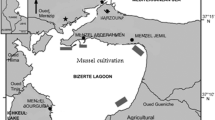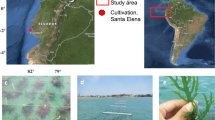Abstract
Extractive seaweed aquaculture is gaining attention in the western Baltic Sea and in particular the co-cultivation with other species for bioremediation or nutrient delivery. However, there are still limitations to viable seaweed production yields in a brackish habitat with a short production period for Saccharina latissima. This investigation presents the specific growth-enhancing effect of Mytilus edulis on the seaweed early nursery stages during the hatchery and during the grow out period at sea in a Baltic fjord. Gametogenesis and juvenile sporophyte development were evaluated with and without blue mussels during 9 weeks of seaweed hatchery. The presence of mussels resulted in a significantly higher abundance of large multicellular sporophytes. After the hatchery period, seedling lines were transferred into the field and installed both in the direct vicinity of and 25 m away from mussel culture ropes. The previously observed supporting effect of mussel co-culture on seaweed development during the hatchery period was still visible after 6 months at sea. Sporophytes were larger, had a higher biomass and had higher carbon content if previously combined with mussels in the hatchery. This investigation suggests that the co-cultivation of seaweed and mussels during seaweed hatchery can increase seaweed crop yields in the following grow out period at sea, with the possibility of being certified organic.








Similar content being viewed by others
References
Abreu MH, Pereira R, Yarish C, Buschmann AH, Sousa-Pinto I (2011) IMTA with Gracilaria vermiculophylla: productivity and nutrient removal performance of the seaweed in a land-based pilot scale system. Aquaculture 312:77–87
Ahn O, Petrell R, Harrison P (1998) Ammonium and nitrate uptake by Laminaria saccharina and Nereocystis luetkeana originating from a salmon sea cage farm. J Appl Phycol 10:333–340
Blidberg E, Gröndahl F, Cahill B, Koreiviene J, Belous O, Shabayeva D (2012) Macroalgae harvesting and cultivation. In: Schultz-Zehden A, Matczak M (eds) SUBMARINER Compendium: an assessment of innovative and sustainable uses of Baltic marine resources. Maritime Institute, Gdańsk, pp 49–76
Brinkhuis BH, Levine HG, Schlenk CG, Tobin S (1987) Laminaria cultivation in the Far East and North America. In: Seaweed cultivation for renewable resources. Developments in aquaculture and fisheries science, 16th edn. Elsevier, Amsterdam, pp 107–146
Broch OJ, Slagstad D (2012) Modelling seasonal growth and composition of the kelp Saccharina latissima. J Appl Phycol 24:759–776
Carlson L (1991) Seasonal variation in growth, reproduction and nitrogen content of Fucus vesiculosus L. in the Öresund, Southern Sweden. Bot Mar 34:447–453
Chapman ARO, Markham JW, Lüning K (1978) Effects of nitrate concentration on the growth and physiology of Laminaria saccharina (Phaeophyta) in culture. J Phycol 14:195–198
Choi JS, Moon WS, Choi JN, Do KH, Moon SH, Cho KK, Han CJ, Choi IS (2013) Effects of seaweed Laminaria japonica extracts on skin moisturizing activity in vivo. J Cosmet Sci 64:193–209
Chopin T, Buschmann AH, Halling C, Troell M, Kautsky N, Neori A, Kraemer GP, Zertuche-González JA, Yarish C, Neefus C (2001) Integrating seaweeds into marine aquaculture systems: a key towards sustainability. J Phycol 37:975–986
Dame RF, Dankers N (1988) Uptake and release of materials by a Wadden sea mussel bed. J Exp Mar Biol Ecol 118:207–216
European Commission (2009) Council Regulation (EC) No 710/2009 amending Regulation (EC) No 889/2008 laying down detailed rules for the implementation of Council Regulation (EC) No 834/2007, as regards laying down detailed rules on organic aquaculture animal and seaweed production
Fei X (2004) Solving the coastal eutrophication problem by large scale seaweed cultivation. Hydrobiologia 512:145–151
Gerard VA (1997) the role of nitrogen nutrition in high-temperature tolerance of the kelp, Laminaria saccharina (Chromophyta). J Phycol 33:800–810
Han T, Kain JM (1996) Effect of photon irradiance and photoperiod on young sporophytes of four species of the Laminariales. Eur J Phycol 31:233–240
Hanelt D, Wiencke C, Karsten U, Nultsch W (1997) Photoinhibition and recovery after high light stress in different developmental and life-history stages of Laminaria saccharina (Phaeophyta). J Phycol 33:387–395
Harrison PJ, Druehl LD, Lloyd KE, Thompson PA (1986) Nitrogen uptake kinetics in three year-classes of Laminaria groenlandica (Laminariales: Phaeophyta). Mar Biol 93:29–35
Holdt SL, Kraan S (2011) Bioactive compounds in seaweed: functional food applications and legislation. J Appl Phycol 23:543–597
Jansen HM, Strand Ø, Verdegem M, Smaal A (2012) Accumulation, release and turnover of nutrients (C–N–P-Si) by the blue mussel under oligotrophic conditions. J Exp Mar Biol Ecol 416–417:185–195
Kain JM (1991) Cultivation of attached seaweeds. In: Guiry MD, Blunden G (eds) Seaweed resources in Europe: uses and potential. Wiley, Chichester, pp 309–379
Kain JM, Dawes CP (1987) Useful European seaweeds: past hopes and present cultivation. Hydrobiologia 151/152:173–181
Kautsky N, Evans S (1987) Role of biodeposition by Mytilus edulis in the circulation of matter and nutrients in a Baltic coastal ecosystem. Mar Ecol Prog Ser 38:201–212
Kotta J, Herkül K, Kotta I, Orav-Kotta H, Lauringson V (2009) Effects of the suspension feeding mussel Mytilus trossulus on a brackish water macroalgal and associated invertebrate community. Mar Ecol 30:56–64
Lüning K (1979) Growth strategies of three Laminaria species (Phaeophyceae) inhabiting different depth zones in the sublittoral region of Helgoland (North Sea). Mar Ecol Prog Ser 1:195–207
Lüning K (1981) Light. In: Lobban CS, Wynne MJ (eds) The biology of seaweeds. Botanical monographs, 17th edn. University of California Press, Berkeley, pp 326–355
Lüning K, Pang S (2003) Mass cultivation of seaweeds: current aspects and approaches. J Appl Phycol 15:115–119
Lüning K, Yarish C, Kirkman H (eds) (1990) Seaweeds: Their environment, biogeography, and ecophysiology. Wiley, New York
MacArtain P, Gill C, Brooks M, Campbell R, Rowland I (2007) Nutritional value of edible seaweeds. Nutr Rev 65:535–543
Matos J, Costa S, Rodrigues A, Pereira R, Sousa Pinto I (2006) Experimental integrated aquaculture of fish and red seaweeds in Northern Portugal. Aquaculture 252:31–42
McHugh DJ (2003) A guide to the seaweed industry. FAO fisheries technical paper. Food and Agriculture Organization of the United Nations, Rome, 441
Nielsen R (1995) Distributional index of the benthic macroalgae of the Baltic Sea area. Baltic Marine Biologists publication, no. 18. Finnish Zoological and Botanical Pub. Board, Helsinki
oceanBASIS GmbH. http://www.oceanbasis.de/actives/algenfarm/polyaquakultur/
Phillips MC (1990) Environmental aspects of seaweed culture: Regional Seafarming Development and Demonstration Project RAS/90/002. Technical research reports, Cebu City, Phillipines
Plew DR, Stevens CL, Spigel RH, Hartstein ND (2005) Hydrodynamic implications of large offshore mussel farms. IEEE J Ocean Eng 30:95–108
Rees T (2007) Metabolic and ecological constraints imposed by similar rates of ammonium and nitrate uptake per unit surface area at low substrate concentrations in marine phytoplankton and macroalgae. J Phycol 43:197–207
Remane A, Schlieper C (1971) Biology of brackish water, 2nd edn., Stuttgart:372 pp.
Rodger AN (2010) Sea-based integrated multi-trophic aquaculture: investigation of a fish, bivalve and macroalgal co-culture system. Ph.D. thesis, University of the Highlands and Islands Millennium Institute
Ruxton CH, Jenkins G (2013) A novel topical ingredient derived from seaweed significantly reduces symptoms of acne vulgaris: a general literature review. J Cosmet Sci 64:219–226
Schlüter L, Josefsen SB (1994) Annual variation in condition, respiration and remineralisation of Mytilus edulis L. in the Sound, Denmark. Helgol Mar Res 48:419–430
Schories D, Selig U, Schygula C (2006) Nutzung mariner Organismen zur Senkung der Nährstoff-Belastung in den Küstengewässer an der Deutschen Ostseeküste – Potentiale und Grenzen. Rostock Meeresbiol Beitr 15:87–104
Seema C, Jayasankar R (2005) Removal of nitrogen load in the experimental culture system of seaweed and shrimp. J Mar Biol Ass India 47:150–153
Wang WJ, Sun XT, Wang FJ (2010) Effect of blue light on early sporophyte development of Saccharina japonica (Phaeophyta). Mar Biol 157:1811–1817
Wasmund N, Schöppe C, Göbel JWM von (2011) Chlorophyll-a in den deutschen Ostseegewässern. Meeresumwelt Aktuell Nord- und Ostsee, 2, Hamburg und Rostock
Widdows J, Fieth P, Worrall CM (1979) Relationships between seston, available food and feeding activity in the common mussel Mytilus edulis. Mar Biol 50:195–207
Xu D, Gao Z, Zhang X, Qi Z, Meng C, Zhuang Z, Ye N (2011) Evaluation of the potential role of the macroalga Laminaria japonica for alleviating coastal eutrophication. Biores Technol 102:9912–9918
Yarish C, Penniman CA, Egan B (1990) Growth and reproductive responses of Laminaria longicruris (Laminariales, Phaeophyta) to nutrient enrichment. Hydrobiologia 204/205:505–511
Acknowledgments
We gratefully acknowledge the assistance of Tim Staufenberger, Verena Sandow and Susanne Woldmann during experimental trial, Marion Zenthoefer for critical discussion and Jennifer Taylor for comments on the manuscript. The project was supported by funds of the Deutsche Bundesstiftung Umwelt (DBU).
Author information
Authors and Affiliations
Corresponding author
Rights and permissions
About this article
Cite this article
Rößner, Y., Krost, P. & Schulz, C. Increasing seaweed crop yields through organic fertilisation at the nursery stage. J Appl Phycol 26, 753–762 (2014). https://doi.org/10.1007/s10811-014-0269-7
Received:
Revised:
Accepted:
Published:
Issue Date:
DOI: https://doi.org/10.1007/s10811-014-0269-7




